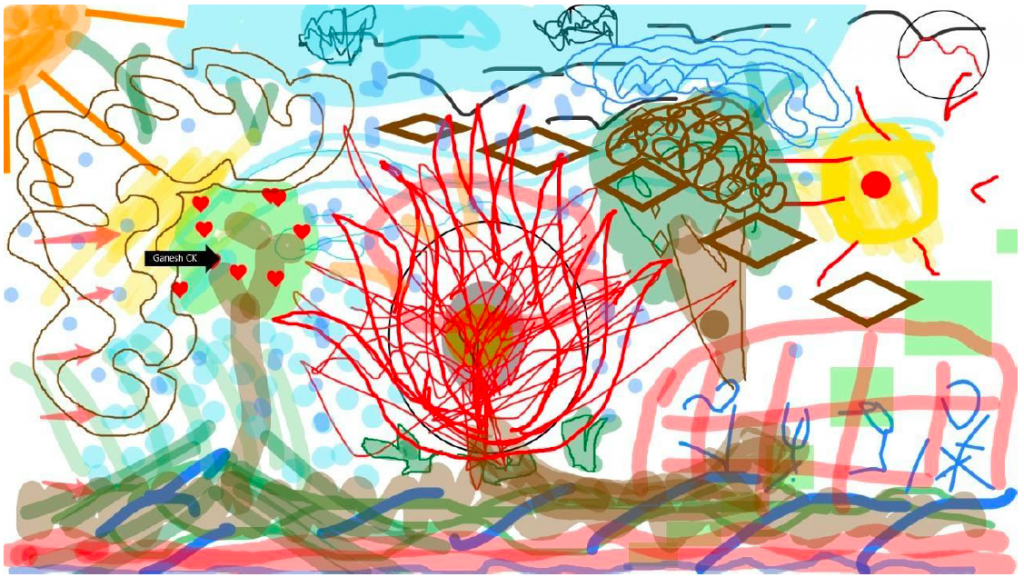“Over a million infected and thousands of deaths”, no it is not a page from history describing the plague or famine but the virulent novel Corona Virus that has brought every country from east to west down to its knees. While the medical fraternity and scientists are testing and studying this phenomenon that is a pandemic now, a few of us wanted to step back from the panic and anxiety to really see what is happening and what does it mean for humanity? All this through the lens of yoga.
Raghu: I think it is very important to start by defining what we mean by Yoga. There are so many people giving Yogic advice to deal with the virus. Let us make it clear that doing Asana and praNAyAma is not necessarily doing yoga. The basic practice is very useful, however, it is not yoga sAdhana. Without going into esoteric meanings, the first step that constitutes yoga is to look at every experience one goes through with the question “what does this teach me about myself and about my world?”. This commitment to contemplation and self-enquiry is essential to taking up yoga sAdhana.
Q: But how does one ask the question and make it the beginning of a sAdhana?
Raghu: What yoga shastrAs, and indeed all Indic philosophies offers you is a framework through which you can examine the question. Just as any scientific enquiry uses instruments through which to examine the world, yogic contemplation requires one to deploy appropriate frameworks need to be applied with rigour.
Q: What is the framework through which one can look at an event as sudden and shattering as the Covid-19?
Raghu: All around people are facing tremendous hardship thanks to the corona virus attack. Lets’s start by using the term duHkha, and examine this phenomenon through the framework of duHkha. I think that’s reasonable.
Q: Yes it is.
Raghu: Firstly, for a person who is taking the sAdhana seriously, duHkha is an invitation to start a process of introspection. The first practice is vairagya i.e., saying no to the urge to escape from distress. These escapes act like a vicious cycle and the more successful the escape seems to be, the more one is repressing one’s suffering and it gains strength! Simultaneously, one begins abhyAsa i.e., a sustained practice to understand the roots of the duHkha and to de-potentize the seeds of duHkha.
Q: Isn’t the pull to escape a very natural response.
Raghu: Yes, it is, but one must understand the difference between something temporary and something that endures. It is possible that if the cause is temporary one can expect the cause to go away in a short time. However, for a person on the path, the goal is a temporary relief but an ending of all the seeds of duHkha within. When one restrains oneself from looking at escapes, there is a lot of energy that can be directed to understanding the inner process and ending it.
Q: What answers does yoga provide?
Raghu: Like I said before, it follows the maxim “give a man a fish you feed him for a day, teach him how to fish and you feed him for a life-time”. Yoga teaches you how to burn the seeds of duHkha, it also offers temporary relief but the energy that is provided by the relief at the symptomatic level must be used for deep cleansing.
Let us start by using a simple frame to understand duHkha.
There are three types of duHkha :
- Adidaivikam– those which are created beyond a human explanation or meaning, so it is referred to as some daivikforce.
- Adibhoutikam– those which are created by forces of nature, just like the corona virus
- adhyAtmikam– those which are created by my own doing.
I feel that the corona virus has some elements of adhyAtmikam duHkha if one takes cognizance of the responsibility we have as a human race for the way we are exploiting nature and disturbing the ecological balance. Many research papers are coming up with this theory on how these viruses are caused because of our intervention into the processes of nature. So, I can take responsibility for the cause of suffering, even if it is to a minimal extent. I take responsibility for the way in which we are dealing with the environment and how that has created this specific kind of duHkha.
I am in control of how I respond to the situation, and the framework to look outside and inside is clearly with me. Are we facing the challenge with a sense of equanimity or not? Any lack of equanimity reflects fear and anxiety. It is not a simple illness that is causing a panic, the fear of being wiped out is the issue. This reflects our own abhiniveShaH, fear of death. The more intense the force of abhiniveShaH, the greater the despair and sense of duHkha. Feeling unwell and depressed go hand in hand with duHkha.
If one is committed to yoga sAdhana it is a great opportunity to look at how one understands death, life, immortality-mortality, survival and so on.
Q. Indeed! We have been acting with constant apuNya(going against the flow of nature); whether it is our consumption of food, attitude to animals, misuse of power. This has led to the virus and the subsequent breakdown of social and economic structures all over the world. What does it mean to act with puNya in today’s world? We have the opportunity to ask this question today. However hard and frustrating it is, I wish we do.
Raghu: ApuNya is not only eating exotic animals and testing one’s immune system capabilities to the maximum, but also how we are devastating the earth constantly. Ebola, SARS, Corona are all outcomes of this destruction.
The frustration that you are experiencing reflects the difficulty we experience in admitting to our own acts of ApuNya and how we collude with acts being done by others. Yoga suggests that we need to look at this process from the place of a sakhi, a friend. With honestly but with affection and gentleness to oneself. How are you creating duHkha for yourself? When others act from ApuNya what is getting triggered in you? Can you watch this with equanimity?
Q. What does “being in Equanimity” mean? No action?
Raghu: Of course not! Equanimity is a very intense space of observation and understanding of one’s reality as is. It requires tremendous energy or tapas.
Q. Why is it so difficult for people to get in touch with this space?
Raghu: I think it is because it triggers fears of death/abhiniveshaH. If you are a sAdhaka you would not run away, but confront the relationship with death. I remember a story of a friend who went to see Krishna ji (J.Krishnamurti) and came back very disturbed after the conversation. Krishna ji asked him a very simple question; “why is your survival so important to you?” This question sums up what is abhiniveshaH.
Q. In one of our online antaranga yogasessions last week, we were hesitant to bring up the topic of the virus because we did not feel equipped to hold the space for that kind of a dialogue. Instead we kept the focus of the session to the practice of yoga. At the end of the session when we were sharing our reflections the topic of death did come up, but I believe each of us was looking at death in a light yet poignant way. Slowly I am getting comfortable with the question of my death, my mortality.
Raghu: Excellent. The ease of flow in the conversation could not have happened had you not seen the issue of death through the lens of equanimity. Such opportunities are wonderful for students and teachers of yoga to look at one’s abhiniveshaH
Q. Isn’t that the fundamental duHkhatoday with the virus?
Raghu: Yes, the fear of death. When I see all the social media posts talking about how we must look inwards not outwards, ‘how to live differently post corona’ or ‘how we are destroying the earth’ I wonder whether these are all examples of smashAna vairAgyam. A response that happens in the wake of visiting the burning ghatsand seeing the body of a friend or loved one being reduced to ashes. When you visit someone’s house for a condolence or you hear about a loved one’s passing away, we have these moments where we talk about ‘how to live better’ or ‘how we should care for things that are important in one’s life’ but the very next morning we go back to our old ways. Have we learnt or changed our ways ever? So many plagues, wars, famines, earthquakes yet we continue our life with ApuNya.
Q. I do feel guilty about my own contribution to the pain we cause to bhUmi devi.
Raghu: At an existential level every person can feel this responsibility, that is why we say that such events are not purely Adibhoutikam.
Q. What does that mean?
Raghu: It is adhyAtmikam because we have contributed to this current context.
Q. In the past few days I have been having bouts of anxiety with respect to the future of my work, not having enough sanitizers or essentials or just that I have so many things to do and fulfill. There is a protective defense that comes up. At times I try and make peace with it but not all the time. What can I do?
Raghu: Can you ask yourself am I just suppressing these anxieties or looking at it from a space of equanimity? I can’t change the context already created, so can I act calmly and do what needs to be done? It is difficult to speak with others who are also anxious, so can you start journaling and honestly own-up to what is happening within? Can you then look at what duHkha’s can happen in future? What actions of mine will create this duHkha? Can I do something now, which will stop it, not from fear, anxiety or guilt but with clarity?
Q. Many a times it feels like a blank mind and then I feel a pull to distract myself saying ‘let us do something interesting rather than look at it now.’
Raghu: So, the first step of the sAdhana is to be able to watch the way the mind responds. Where is this coming from- whether it is a fear of death, escapist tendency or even equanimity. Understanding where the mind is acting from and in what contexts? This is the upeksha at the time of ApuNya. These are steps recommended in the Yoga sutra in the first chapter.
Q. What about things like immunity ? How do we look at the inner constitution of a person?
Raghu: Ayurveda has an interesting framework when it comes to how does a person contracts an illness. There are three aspects to this-:
- pariNAma– Or change. This change can be anything like change of seasons or external contexts. Seasonal changes cause difficulty to a certain kind of prakRti or body constitution and not to others. This change is from the outside i.e., Adidaivikam or Adibhoutikam. If I understand my system properly then I can anticipate the change and I can prepare for it.
- asAtmiya indriya samyogamwhich means ‘are each of my indriyAs healthy or wholesome and are they engaging with the world optimally?’ asAtmiya means inappropriate, whether the samyoga between my indriyA and the world around me is optimally balanced or not. There is a great stress on washing one’s hands, using a sanitizer to avoid the spread of the corona virus. This is avoiding wrong contact, but worrying to the extent of getting obsessed is not a healthy way in which my indriyA are interacting with the world. A practice of Asana, prANAyama, exercising and so on are ways of dealing with the indriyA at the gross level. But if I go a bit deeper to understand the workings of my whole body/mind system, then I will start examining the ways in which I observe the yamA-niyamAs of my life. I ask myself whether I am following ahimsA, satya, asteya, brhmachrya and aparigraha in my engagement with the world. When for example social distancing or isolation is prescribed and we are not ready for it, the usual way in which we manage our appetites for example will get disturbed. If we have not built any meditative or internal practice into our lives, we will experience a lot of restlessness. For e.g. many people are showing signs of depression, anxieties and loneliness during times like this. Where is this restlessness coming from? What inner appetites are getting triggered and are these appetites managed in a way that is balanced? If they have been held in balance, then the current do’s or don’ts would not throw people off balance. These appetites tell me what I am feeding my indriyA with currently.
- prajnyAparAdham means a mind that is disturbed. So, if there is asAtmiya indriya samyogamand there is prajnyAparAdham , my mind is unstable, I am not mindful when I engage with the world. Thus, my state of mind will affect the epigenetic processes in the body and impact the immune systems. This has been studied and Bruce Lipton has written about it in The Biology of Belief. Just observe how your sleep patterns, food habits and responses to the world change when the mind is disturbed. The body will contract some infection sooner or later because its immunity will be weakened.
- How does Ayurveda or yoga explain the spread of an infection into a pandemic or epidemic? The spread to a larger community or groups is something very different from an individual falling ill?
Raghu: There is a discussion in the Ayurvedic texts where an interesting question is raised. The discussion starts by saying that microscopic agents that one cannot see carries disease. But only some people fall ill, and others don’t. Why does this happen? It concludes by saying that the field in which the disease grows is the individual’s body, and its ability to fight off the external agency. Therefore, it goes on to say that while shamanam i.e., symptomatic treatment is important, shodhanam i.e., cleansing and Arogyam i.e., strengthening the body to fight off all illness is the final cure. It places great emphasis on building immunity through proper food and exercise. Being careful of what one touches, eats and engages with is part of the practice to contain the spread of disease. A 42 or 49 day quarantine has been routinely practiced in many disease conditions. Village traditions of quarantine in the case of contagious diseases like small pox has been around for centuries.
Q. What does all of it mean in a practical sense of daily living?
Raghu: Firstly, look at the relationship between the indriyas and objects around you, how are you triggered by them and what makes you feed or starve them? Then, the prajnyAparAdham is how am I dealing with the reality of sukha and duHkha that the world throws up continuously. The world is going to continue to act in a certain way and, the context will also do the same. Some of the ways in which the context acts will produce sukha and some acts will produce duHkha. So, the experience of sukha and duHkha is not under my control. But What is under my control is the anushayi or process of the response. Am I creating rAga (attraction) and dvesha (aversion) in myself?
So, if I create rAga which is pleasure seeking or if I create dvesha which is an aversion to any negative experience, this is the anushayi process. When I get caught with the anushayi process, I am creating disturbances in my psyche and it will drive an inappropriate use of my indriya. The field of illness is weakened by this inner disturbance and loss of mindfulness.
The frameworks of asAtmiya indriya samyogam, prajnyAparAdham and the anushayi process (sukha anushayi or duHkha anushayi) are beautiful mirrors through which to look at ourselves. What causes the disturbance and the inappropriate engagement? If I am caught with pleasure seeking or pain avoidance, then I will constantly be in a vigilant state. My whole body and being will be in a heightened state like a fighter, and I will look at the world in terms of opportunities and threats. Thus, my body will be in constant arousal response to the world and would be reactive and jumpy.
Q. I see these responses in every space-family, corporate, government and many others. I don’t think the understanding of basic humanness is really held in wholesomeness.
Raghu: Unfortunately, today’s idea of a good life promotes unhealthy ways of living and relating to one’s world.
Q. Is this mindset linked to how we are experiencing ourselves- physically and mentally in the state of lockdown, with panic and fear?
Raghu: Yes, this hyper vigilance will automatically lead to feelings of loneliness, lack of community and may trigger certain appetites for food and other indulgences. The virus if you consider it as a blessing is showing the reality of human beings. What on earth would you do all by yourself anyway? How long can you just act to protect yourself? If this pandemic, triggers a move towards self-reflection then it would be great.
Q. As a yoga teacher and practitioner, how do I work with myself?
Raghu: The world is continuously pushing ways and things that are not needed and are a waste. This yuga dharma of commerce is the current colonizing idea of the world. One needs to be aware if one is being pulled into bhogam or negative spiral, leading to ill-health or apavargam that represents a period of quiet reflection with a greater possibility of keeping your health in balance. Keeping this hope alive without running away from reality and your responsibility towards it is a true yogic practice.



 Priya is a Yoga therapist in the Krishnamacharya tradition. She adapts Reiki & energy work, Vedic chanting, life coaching & Ayurvedic practices in her healing spaces. She is committed to nurturing collectives that have the praxis of Yoga at their heart.
Priya is a Yoga therapist in the Krishnamacharya tradition. She adapts Reiki & energy work, Vedic chanting, life coaching & Ayurvedic practices in her healing spaces. She is committed to nurturing collectives that have the praxis of Yoga at their heart. Anisha has been on an exploration to understand herself through yoga for the last 15years which led her to teaching yoga, yoga therapy and inner work through yoga.
Anisha has been on an exploration to understand herself through yoga for the last 15years which led her to teaching yoga, yoga therapy and inner work through yoga. Apoorva chanced upon Yoga in her early 20s. A spark was lit within and there was no turning back. Her exploration led her to the Krishnamacharya tradition more than a decade ago. Curious about human behaviour and what drives it, she was thrilled when her search ended (and also began) when she first came upon the Yoga Sutra, which illuminated a path towards answering many questions that had been held for a long time.
Apoorva chanced upon Yoga in her early 20s. A spark was lit within and there was no turning back. Her exploration led her to the Krishnamacharya tradition more than a decade ago. Curious about human behaviour and what drives it, she was thrilled when her search ended (and also began) when she first came upon the Yoga Sutra, which illuminated a path towards answering many questions that had been held for a long time. Anita is a yoga teacher and therapist in the tradition of Sri.T.Krishnamacarya and Sri T.K.V. Desikachar, a Reiki practitioner and a Life Coach. She is also the founder of Vishoka, a center for learning Indic and energy-based frameworks for living and healing. Her deep concern for human suffering and the problems of unsustainable living kept her on the path of seeking an integrated approach to looking at life, living, learning and healing.
Anita is a yoga teacher and therapist in the tradition of Sri.T.Krishnamacarya and Sri T.K.V. Desikachar, a Reiki practitioner and a Life Coach. She is also the founder of Vishoka, a center for learning Indic and energy-based frameworks for living and healing. Her deep concern for human suffering and the problems of unsustainable living kept her on the path of seeking an integrated approach to looking at life, living, learning and healing. Ankit is a seeker in the wisdom traditions of India. The core of his work includes creating dialogic spaces where people can look within and see the connection between their inner and outer lives. Inspired by the likes of Gandhi, Aurobindo, Vivekananda and Guru Gobind his experiments in service took him back to his roots in Punjab where he is creating a community-led model of higher education which is open, inclusive and accessible for all. Ritambhara for him is a space for engaging in a community which is committed to a DHramic life. He anchors his work of learning and leadership in the Antaranga Yoga Sadhana and the humanistic wisdom of Mahabharata.
Ankit is a seeker in the wisdom traditions of India. The core of his work includes creating dialogic spaces where people can look within and see the connection between their inner and outer lives. Inspired by the likes of Gandhi, Aurobindo, Vivekananda and Guru Gobind his experiments in service took him back to his roots in Punjab where he is creating a community-led model of higher education which is open, inclusive and accessible for all. Ritambhara for him is a space for engaging in a community which is committed to a DHramic life. He anchors his work of learning and leadership in the Antaranga Yoga Sadhana and the humanistic wisdom of Mahabharata.
The Yoga as a science of creating integrated balance is the need of the hour for our response to this viral pandemic. This is a timely and integrated understanding of how our collective actions such as our unrestrained exploitation of earth resources which disturbed the balance of natural order can unleash the worldwide calamity that we are seeing at this time of Covid-19 pandemic.
The real question is are we as a human species abele to grasp our inexorable interconnectedness and interdependence of all beings of the planet Earth?
Do the dominant economic paradigm of Earth’s resources are for my enjoyment rooted in its metaphorical beliefs could grasp it?
Could the Dharmic and Adharmic forces be aligned in bringing about the sustainable balance?
Thank you. I think it is important that we continue this exploration and the only way a dharmic way forward is through a dialogue